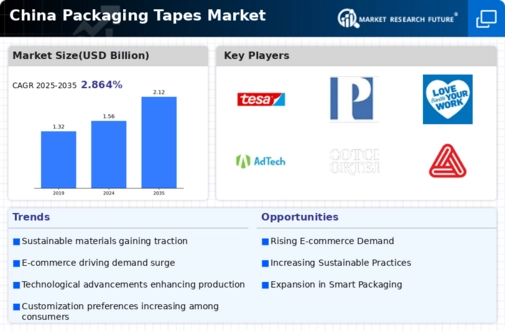Rising Demand from E-commerce
The rapid expansion of the e-commerce sector in China is a primary driver for the packaging tapes market. As online shopping continues to gain traction, the need for efficient and reliable packaging solutions has surged. In 2025, the e-commerce market in China is projected to reach approximately $2 trillion, necessitating robust packaging materials to ensure product safety during transit. Packaging tapes play a crucial role in securing packages, thereby enhancing customer satisfaction and reducing return rates. This trend indicates a sustained demand for high-quality packaging tapes, as businesses strive to meet consumer expectations for timely and intact deliveries. Consequently, the packaging tapes market is likely to experience significant growth, driven by the increasing volume of shipments and the need for effective packaging solutions.
Increased Manufacturing Activities
China's manufacturing sector remains a cornerstone of its economy, contributing significantly to the packaging tapes market. As of 2025, the manufacturing output is expected to account for over 30% of the country's GDP, leading to heightened demand for packaging materials. Industries such as electronics, automotive, and consumer goods rely heavily on packaging tapes for product assembly and shipping. The growth in manufacturing activities not only boosts the demand for packaging tapes but also encourages innovation in tape production, including the development of specialized tapes for various applications. This dynamic environment suggests that the packaging tapes market will continue to thrive, supported by the ongoing expansion of manufacturing capabilities across diverse sectors.
Sustainability Trends in Packaging
The growing emphasis on sustainability is significantly impacting the packaging tapes market in China. As consumers become more environmentally conscious, companies are increasingly seeking eco-friendly packaging solutions. By 2025, it is projected that the demand for sustainable packaging materials will rise by 30%, prompting manufacturers to innovate and develop biodegradable and recyclable packaging tapes. This shift towards sustainability not only aligns with consumer preferences but also helps companies comply with government regulations aimed at reducing plastic waste. Consequently, the packaging tapes market is expected to evolve, with a greater focus on sustainable practices, potentially leading to new market entrants and increased competition.
Technological Innovations in Production
Technological advancements in manufacturing processes are reshaping the packaging tapes market in China. Innovations such as automated production lines and advanced adhesive technologies are enhancing efficiency and product quality. In 2025, it is expected that the adoption of smart manufacturing techniques will increase by approximately 25%, leading to faster production cycles and reduced costs. These advancements not only improve the performance of packaging tapes but also allow for customization to meet specific customer needs. As manufacturers leverage technology to enhance their offerings, the packaging tapes market is likely to witness a transformation, characterized by improved product features and greater market competitiveness.
Regulatory Compliance and Safety Standards
The implementation of stringent regulatory frameworks in China is influencing the packaging tapes market. As industries face increasing scrutiny regarding product safety and environmental impact, compliance with safety standards becomes paramount. Packaging tapes must meet specific criteria to ensure they are safe for use in various applications, particularly in food and pharmaceuticals. In 2025, it is anticipated that more than 60% of companies will prioritize compliance with these regulations, driving demand for certified packaging tapes. This trend indicates a shift towards higher quality and safer packaging solutions, which could reshape the competitive landscape of the packaging tapes market, favoring manufacturers who can meet these evolving standards.


















Leave a Comment